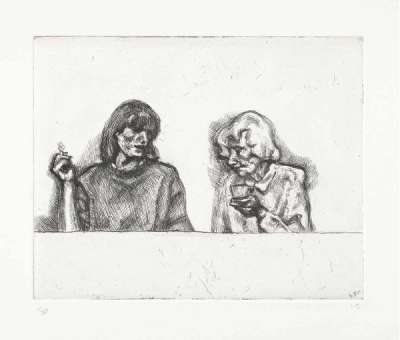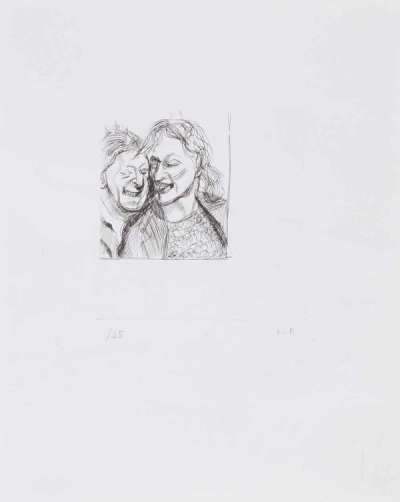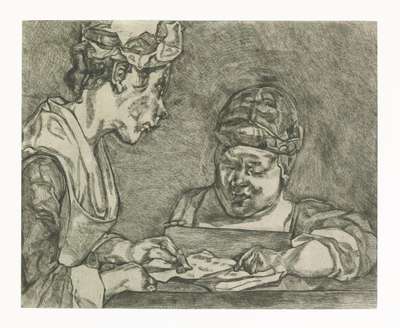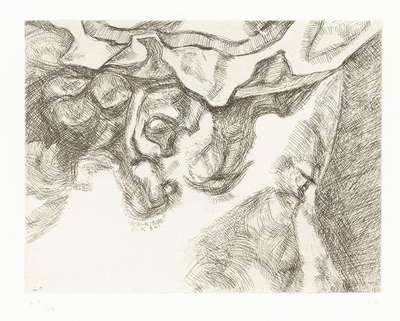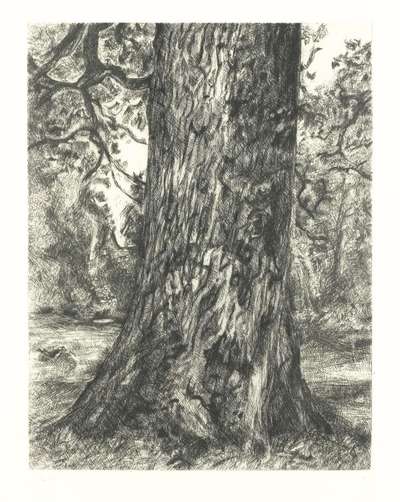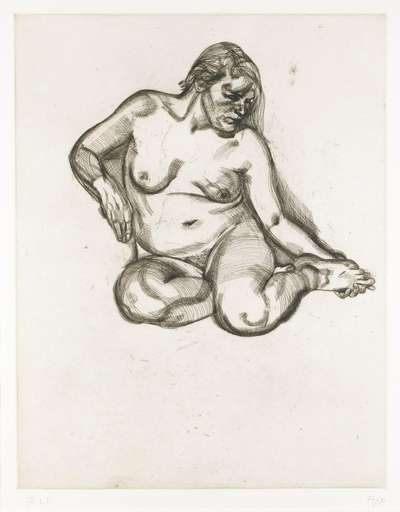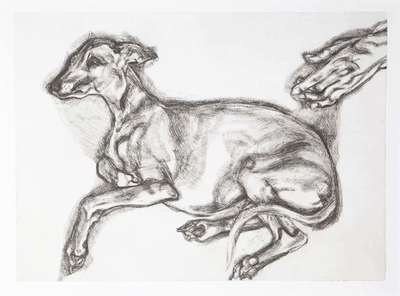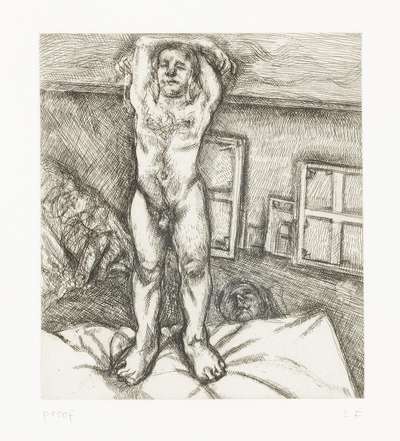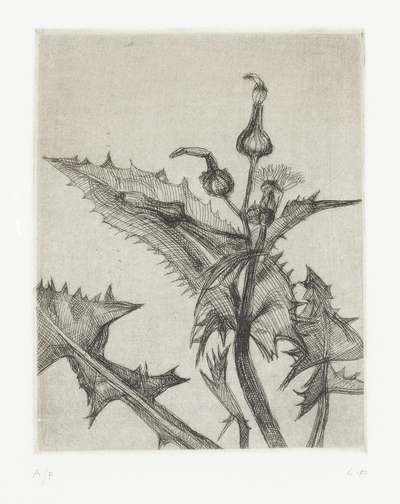Behind the Costumes: Lucian Freud's Representations of Leigh Bowery
 Head Of Man II © Lucian Freud 1992
Head Of Man II © Lucian Freud 1992
Lucian Freud
57 works
When the revered master of figurative art Lucian Freud met Leigh Bowery, a provocative performance artist, an unexpected and iconic artistic collaboration was born. Delving into this collaboration reveals a vibrant intersection of art and identity; an unconventional dance between portrait painting and costume art. Unravelling the symbolism and techniques behind Freud's portrayal of Bowery, it is possible to uncover the story beneath the art, examining the threads that weave the intricate fabric of their artistic partnership.
Leigh Bowery: The Provocative Performance Artist
Born in Australia, Leigh Bowery rapidly rose to prominence in the heart of London's club scene in the 1980s. His unique vision pushed the boundaries of queer performance art, defying traditional categorisation; Bowery was an embodiment of bold self-expression, weaving together art and fashion in a flamboyant and shocking display. His costumes blurred the line between the surreal and the beautiful, appearing in a new outfit every week at the infamous nightclub Taboo.
Often controversial and occasionally downright offensive, his audacious performances were a potent statement of identity that captivated audiences. From his costumes to his stage antics, Bowery was inspired by extremes. Nonetheless, his outfits reflected an engagement with queer aesthetics at a time when the stigma of gay individuals was peaking due to the AIDS crisis. His defiant self-costuming was a subversive act of queer visibility.
Lucian Freud: The Master of Figurative Painting
In the annals of 20th-century art, Lucian Freud commands a special place. Born into an illustrious lineage as the grandson of Sigmund Freud, Lucian carved out his own distinctive path in the realm of contemporary art. Over a career spanning seven decades, he mastered the art of figurative painting, rendering the human body with unprecedented intimacy and brutal honesty. His art style, marked by thickly layered paint and dense, impasto technique, exposed the vulnerability of his subjects with a captivating intensity.
Freud's fascination with the human form was unquenchable. He sought subjects who compelled him, who challenged conventional beauty standards, who offered something beneath the skin that intrigued him. In Leigh Bowery, he found all these characteristics and more. In stark contrast to the characteristic quietude of Freud’s subjects, the audacious performance artist with his flamboyant costumes and unabashed self-expression stood out as a different kind of muse.
 Image © Creative Commons via Flickr / Lucian Freud (with Leigh Bowery seated works) © Bruce Bernard 2008
Image © Creative Commons via Flickr / Lucian Freud (with Leigh Bowery seated works) © Bruce Bernard 2008Uncovering the Personal Lives of Lucian Freud and Leigh Bowery
Despite their shared passion for pushing the boundaries of art, Lucian Freud and Leigh Bowery's personal lives were remarkably different. Freud, born in Berlin in 1922, relocated to Britain in 1933 to escape Nazi persecution. As the grandson of the famed psychoanalyst Sigmund Freud, he hailed from a lineage steeped in intellectual prowess. However, Lucian crafted his own identity, one underscored by his undeniable talent in art and complex personal life. Known for his tumultuous relationships, Freud fathered several children from various relationships, his private life often mirroring the intensity of his art.
On the other hand, Leigh Bowery was born in the suburbs of Melbourne, Australia in 1961, and moved to London in the early 80s, immersing himself in the vibrant subculture of the city. Known for his outlandish and flamboyant personality, Bowery often became the talk of the town, whether through his outrageous club performances or the head-turning ensembles he sported. Despite his audacious public persona, Bowery kept his personal life rather private. As a gay man, his marriage to close friend Nicola Bateman in 1994 elicited some speculation. The complexity of their relationship is captured in Freud’s 1993 painting of the couple, And the Bridegroom.
Though their personal lives were marked by distinct trajectories, Freud and Bowery shared an inheritance in their mutual pursuit of self-expression. Both had a profound impact on their respective spheres, their shared legacy immortalised in the captivating portraits Freud created of Bowery. These art pieces offer an intimate glimpse into their lives with the lines, forms, and hues revealing as much about the painter as they do about the muse.
The Artistic Collaboration: Leigh Bowery as Lucian Freud's Muse
Freud and Bowery's encounter at Anthony d'Offay Gallery in 1988 ignited the spark for one of the most intriguing artistic partnerships of the era. Bowery, with his powerful physical presence and unusual appearance, captivated Freud. The artist sought in his subjects a certain rawness, a compelling individuality that could be transferred onto canvas.
In a world often reserved for traditional beauty, Bowery became a paradoxical muse for Freud. His larger-than-life figure and jaw-dropping costumes attracted the artist’s attention as a master of figurative painting. With his penchant for capturing the human form in all its rawness, he was fascinated by Bowery's body—not a traditionally masculine sitter, but undeniably compelling. It was in the rich tapestry of Bowery's life, as well as the vibrant and provocative costumes he wore, that Freud found an unexpected muse.
This collaboration gave rise to a series of paintings that featured Bowery as the leading character in Freud's artistic narrative. The first in the series, Leigh Bowery (Seated) stands as a testament to Freud's ability to capture the nuanced interplay between physical form and a person’s presence. Bowery, in his remarkable scale and form, is painted with a fascinating level of intimacy and detail. His body, candidly exposed, defies traditional notions of beauty while also portraying a remarkable sense of grandeur and grace.
 Image © Tate / Leigh Bowery © Lucian Freud 1991
Image © Tate / Leigh Bowery © Lucian Freud 1991Freud's portrayal of Bowery was often marked by his distinctive impasto technique, where thick layers of oil paint built up a textured, almost tactile quality to the skin. He employed this method to emphasise the physicality of his subjects, adding depth and dimension to the human form. In capturing Bowery, Freud's art technique also evolved as he adapted to represent the enigmatic performer.
The Bowery paintings in Freud’s oeuvre also display his engagement with queer experiences and marginalised bodies. Freud depicted Bowery in several stages of his fight with AIDS, depicting the final years of his life with dignity and elegance. The artist completed his final painting of Bowery posthumously. In Small Head of Leigh Bowery, we see a peaceful and noticeably thinner Bowery, contrasting with the larger-than-life depictions of him in previous portraits.
The Legacy of Lucian Freud and Leigh Bowery
The extraordinary partnership between Lucian Freud and Leigh Bowery opened new avenues in the exploration of contemporary art and identity. Freud's hauntingly beautiful representations of Bowery defied traditional norms, reimagining the concept of beauty and the human form in portraiture. Their collaboration had a ripple effect, influencing artists and movements far beyond their immediate circles.
On their shared canvas, they challenged the status quo, inspiring a generation of artists to embrace the unconventional. At the same time, their collaboration stood as a raw exploration of the queer experience in the context of the HIV/AIDS crisis. The intimacy and admiration portrayed by a masterful painter created a unique kind of visibility.
Today, Freud and Bowery's collaboration stands as a testament to the power of artistic innovation, their legacy pervading the realms of both figurative art and performance. The enduring significance of their partnership is encapsulated in the transformative power of their art. It serves as a reminder that the essence of art lies in the unique perspective it brings to the human condition.
The Enduring Appeal of Lucian Freud and Leigh Bowery's Art
Recent developments have further cemented Bowery’s status as a transformative cultural icon. In February 2025, Tate Modern opened a major retrospective exhibition titled Leigh Bowery!, which is running until August 2025. The show assembles a rich array of original costumes, personal sketches, archival photographs, and several intimate portraits by Freud. This dynamic exhibition renews scholarly and public dialogue about how Freud’s monumental depictions of Bowery encapsulate the interplay between art, identity, and performance.
The collaboration between Freud and Bowery continues to speak to modern audiences. Their artistic connection manifested as a dazzling set of canvases that celebrate performance, portraiture, and queer identity. With Freud’s portraits punctuating the final years of Bowery’s life, the series also serves as a deeply personal eulogy to the late performer.
Undoubtedly, Freud's unflinching portrayal of Bowery has imprinted on our understanding of figurative art, while Bowery's audacious self-expression pushed the boundaries of art, fashion, and performance. As a partnership, they celebrated a liberating conception of beauty that lives on in the Bowery portraits.








